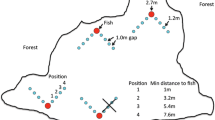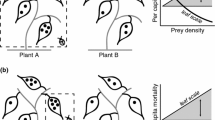Abstract
Foraging theory predicts that predators should prefer foraging in habitat patches with higher prey densities. However, density depends on the spatial scale at which a “patch” is defined by an observer. Ecologists strive to measure prey densities at the same scale that predators do, but many natural landscapes lack obvious, well-defined prey patches. Thus one must determine the scale at which predators define patches of prey. We estimated the scale at which guppies, Poecilia reticulata, selected patches of zooplankton prey using a behavioral assay. Guppies could choose between two prey arrays, each manipulated to have a density that depended on the spatial scale at which density was calculated. We estimated the scale of guppy foraging by comparing guppy preferences across a series of trials in which we systematically varied the scale associated with “high” prey density. This approach enables the application of foraging theory to non-discrete habitats and prey landscapes.



Similar content being viewed by others

References
Abrahams MV (1989) Foraging guppies and the ideal free distribution: the influence of information on patch choice. Ethol 82:116–126
Bates D, Maechler M, Bolker B (2012) lme4: linear mixed-effects models using S4 classes. R package version 0.999999-0. http://CRAN.R-project.org/package=lme4
Bax NJ (1998) The significance and prediction of predation in marine fisheries. ICES J Mar Sci 55:997–1030
Bergman CM, Fryxell JM, Gates CC, Fortin D (2001) Ungulate foraging strategies: energy maximizing or time minimizing? J Anim Ecol 70:289–300
Bolker BM, Brooks ME, Clark CJ, Geange SW, Poulsen JR, Stevens MHH, White JSS (2009) Generalized linear mixed models: a practical guide for ecology and evolution. Trends Ecol Evol 24:127–135
Bond AB (1980) Optimal foraging in a uniform habitat: the search mechanism of the green lacewing. Anim Behav 28:10–19
Burger AE, Hitchcock CL, Davoren GK (2004) Spatial aggregations of seabirds and their prey on the continental shelf off SW Vancouver Island. Mar Ecol Prog Ser 283:279–292
Cowie RJ (1977) Optimal foraging in great tits (Parus major). Nature 268:137–139
Cummings VJ, Schneider DC, Wilkinson MR (1997) Multiscale experimental analysis of aggregative responses of mobile predators to infaunal prey. J Exp Mar Biol Ecol 216:211–227. doi:10.1016/S0022-0981(97)00097-X
Day RL, MacDonald T, Brown C et al (2001) Interactions between shoal size and conformity in guppy social foraging. Anim Behav 62:917–925
Elliott NC, Kieckhefer RW (2000) Response by coccinellids to spatial variation in cereal aphid density. Popul Ecol 42:81–90
Emlen JM (1966) The role of time and energy in food preference. Am Nat 100:611–617
Fisher RA (1932) Statistical methods for research workers, 4th edn. Oliver and Boyd, Edinburgh
Gelman A, Hill J (2007) Data analysis using regression and multilevel/hierarchical models. Cambridge University Press, Cambridge
Gelman A, Su Y-S (2013) arm: data analysis using regression and multilevel/hierarchical models. R package version 1.6-04. http://CRAN.R-project.org/package=arm
Hurlbert SH, Lombardi CM (2009) Final collapse of the Neyman-Pearson decision theoretic framework and rise of the neoFisherian. Ann Zool Fenn 46:311–349
Ioannou CC, Krause J (2008) Searching for prey: the effects of group size and number. Anim Behav 75:1383–1388
Ioannou CC, Morrell LJ, Ruxton GD, Krause J (2009) The effect of prey density on predators: conspicuousness and attack success are sensitive to spatial scale. Am Nat 173:499–506
Johnson CJ, Parker KL, Heard DC (2001) Foraging across a variable landscape: behavioral decisions made by woodland caribou at multiple spatial scales. Oecologia 127:590–602
Krebs JR, Davies NB (1986) Behavioural ecology. Blackwell Science, Sussex
Krebs JR, Ryan JC, Charnov EL (1974) Hunting by expectation or optimal foraging? A study of patch use by chickadees. Anim Behav 22:953–964
Lachmann M, Sell G, Jablonka E (2000) On the advantages of information sharing. Proc R Soc Lond B 267:1287–1293
Landeau L, Terborgh J (1986) Oddity and the ‘confusion effect’ in predation. Anim Behav 34:1372–1380
Levin SA (1992) The problem of pattern and scale in ecology: the Robert H. MacArthur Award Lecture. Ecology 73:1943–1967
Lima SL (2002) Putting predators back into behavioral predator–prey interactions. Trends in Ecol Evol 17:70–75
MacArthur RH, Pianka ER (1966) On optimal use of a patchy environment. Am Nat 100:603–609
Mangel M, Clark CW (1986) Towards a unified foraging theory. Ecology 67:1127–1138
Mohd Norowi H, Perry JN, Powell W, Rennolls K (2000) The effect of spatial scale on interactions between two weevils and their parasitoid. Ecol Entomol 25:188–196
Osborne JL, Martin AP, Carreck NL et al (2008) Bumblebee flight distances in relation to the forage landscape. J Anim Ecol 77:406–415
Osenberg CW, St. Mary CM, Schmitt RJ et al (2002) Rethinking ecological inference: density dependence in reef fishes. Ecol Lett 5:715–721
Overholtzer-McLeod KL (2006) Consequences of patch reef spacing for density-dependent mortality of coral-reef fishes. Ecology 87:1017–1026
Pitcher TJ, Parrish JK (1993) Functions of shoaling behavior in teleosts. In: Pitcher TJ (ed) Behaviour of teleost fishes. Chapman and Hall, London, pp 363–439
Pyke GH (1978) Optimal foraging: movement patterns of bumblebees between inflorescences. Theor Popul Biol 13:72–98
Pyke GH, Pulliam HR, Charnov EL (1977) Optimal foraging: a selective review of theory and tests. Q Rev Biol 52:137–154
Ray C, Hastings A (1996) Density dependence: are we searching at the wrong spatial scale? J Anim Ecol 65:556–566
R Core Team (2012) R: A language and environment for statistical computing. R Foundation for Statistical Computing, Vienna, Austria. http://www.R-project.org/
Schellhorn NA, Andow DA (2005) Response of coccinellids to their aphid prey at different spatial scales. Popul Ecol 47:71–76
Schneider DC, Piatt JF (1986) Scale-dependent correlation of seabirds with schooling fish in a coastal ecosystem. Mar Ecol Prog Ser 32:237–246
Smith JNM, Sweatman HPA (1974) Food-searching behavior of titmice in patchy environments. Ecology 55:1216–1232
Stephens DW, Krebs JR (1986) Foraging theory. Princeton University Press, New Jersey
Stiling P, Throckmorton A, Silvanima J, Strong DR (1991) Does spatial scale affect the incidence of density dependence? A field test with insect parasitoids. Ecology 72:2143–2154
Swaney W, Kendal J, Capon H et al (2001) Familiarity facilitates social learning of foraging behaviour in the guppy. Anim Behav 62:591–598
Townsend CR, Winfield IJ (1985) The application of optimal foraging theory to feeding behavior in fish. In: Fish energetics. Springer, the Netherlands, pp 67–98
Turchin P, Kareiva P (1989) Aggregation in Aphis varians: an effective strategy for reducing predation risk. Ecology 70:1008–1016
Waage JK (1979) Foraging for patchily-distributed hosts by the parasitoid, Nemeritis canescens. J Anim Ecol 48:353–371
Wellenreuther M, Connell SD (2002) Response of predators to prey abundance: separating the effects of prey density and patch size. J Exp Mar Biol Ecol 273:61–71
Werner EE, Hall DJ (1974) Optimal foraging and the size selection of prey by the bluegill sunfish (Lepomis macrochirus). Ecology 55:1042–1052
White JW (2011) Can inverse density dependence at small spatial scales produce dynamic instability in animal populations? Theor Ecol 4:357–370
White JW, Warner RR (2007) Safety in numbers and the spatial scaling of density-dependent mortality in a coral reef fish. Ecology 88:3044–3054
White JW, Samhouri JF, Stier AC, Wormald CL, Hamilton SL, Sandin SA (2010) Synthesizing mechanisms of density dependence in reef fishes: behavior, habitat configuration, and observational scale. Ecology 91:1949–1961
Wrona FJ, Dixon RWJ (1991) Group size and predation risk: a field analysis of encounter and dilution effects. Am Nat 137:186–201
Zach RJ, Falls JB (1976) Ovenbird (Aves: Parulidae) hunting behavior in a patchy environment: an experimental study. Can J Zool 54:1863–1879
Acknowledgments
The authors would like to thank Matt Kon and Joanna Lewis for assistance with animal care. M. A. Birk would also like to thank Dr. Fredrick Scharf and Dr. Mark Galizio for being committee members of this thesis and Jesus Christ for this opportunity. This study was funded by the UNCW Department of Biology and Marine Biology and a UNCW Center for the Support of Undergraduate Research and Fellowships Research Supplies Grant. All research was conducted in accordance with all applicable laws and rules set forth by the USA and the UNCW Institutional Animal Care and Use Committee.
Conflict of interest
The authors declare that they have no conflict of interest.
Author information
Authors and Affiliations
Corresponding author
Additional information
Communicated by Steven Kohler.
Electronic supplementary material
Below is the link to the electronic supplementary material.
Rights and permissions
About this article
Cite this article
Birk, M.A., White, J.W. Experimental determination of the spatial scale of a prey patch from the predator’s perspective. Oecologia 174, 723–729 (2014). https://doi.org/10.1007/s00442-013-2818-1
Received:
Accepted:
Published:
Issue Date:
DOI: https://doi.org/10.1007/s00442-013-2818-1



